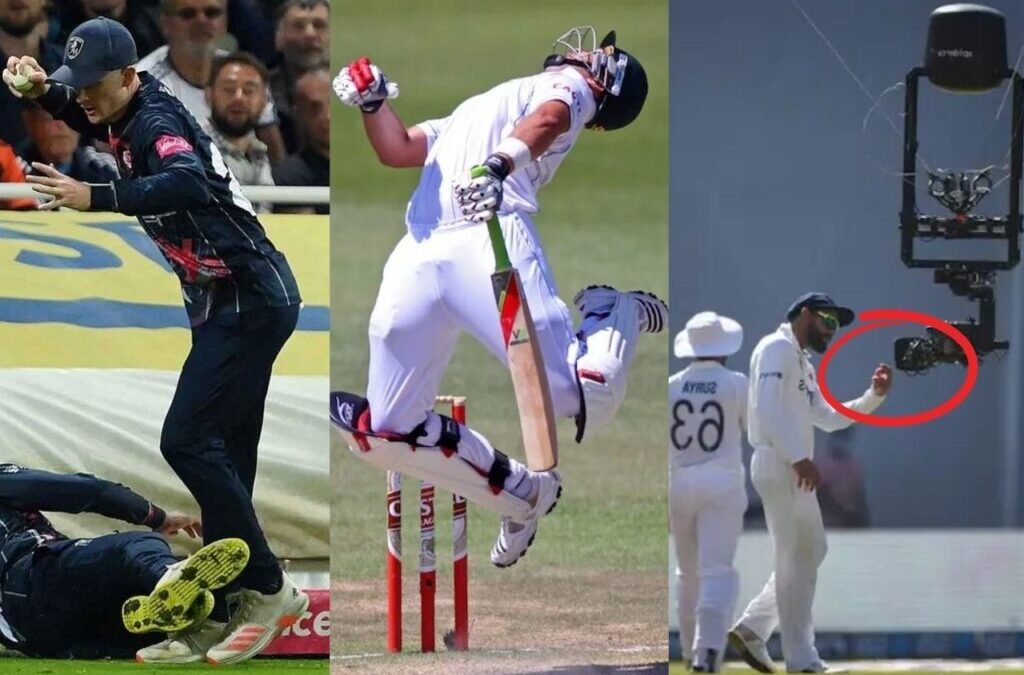Cricket is often romanticised for its rich traditions and gentlemanly origins, but tucked within its rulebook are some laws that may leave even seasoned fans scratching their heads. While most of us know the basics of batting, bowling, and fielding, there exists a strange set of rules that are rarely talked about, yet very much part of the modern game.
1. “Handled the Ball” is No Longer a Standalone Way to Get Out
- Law: Now covered under Law 37 : Obstructing the Field
Explanation: Previously, a batter could be dismissed for simply touching the ball with their hand, even unintentionally, without the fielding side’s consent. However, since 2017, this has been absorbed under the broader umbrella of “obstructing the field.”
- The batter is still out if they touch the ball intentionally and without permission.
- But there is no separate dismissal called “Handled the Ball” anymore.
2. Batter Can Be Out Without Facing a Ball
- Law: Run Out, Obstructing the Field, and Timed Out
Explanation: Strange but true, a batter can be dismissed without facing a single ball. This includes being run out at the non-striker’s end, getting timed out (now 2 minutes as per 2025 rules), or obstructing the field during a changeover. No deliveries faced, no runs scored—still out.
Examples include:
- Getting run out while running as a non-striker
- For instance, a batter can be dismissed without facing a delivery if they are run out at the non-striker’s end while attempting a run.
- Being declared “Timed Out” for not reaching the crease within the stipulated time (now 2 minutes as per 2025 update)
- Getting out for obstructing the field during a changeover
- Zero balls. Zero runs. Still… out.
3. Wicketkeeper Cannot Move Too Early
- Law: Law 27.4 : Movement by the Wicketkeeper
Explanation: The wicketkeeper must stay still until the ball reaches the batter or passes the stumps. Any early movement is deemed unfair and can lead to a dead ball or no-ball, ensuring the batter isn’t unfairly distracted.
- Any premature movement before that moment is considered unfair, and the delivery may be ruled a dead ball or a no-ball in certain situations.
- This rule protects the batter from deception and interference.
4. Fielders Wearing Gloves Incur Penalty Runs
- Law: Law 28.2.1
Explanation: Fielding gloves are strictly reserved for the wicketkeeper.If any other fielder attempts to field the ball with gloves or any external artificial aid, the batting side is awarded 5 penalty runs.
- Even loose gloves lying on the ground and touching the ball can trigger this penalty.
- So yes, gloves are a liability if you’re not behind the stumps.
5. Playing Without Bails Is Legal Under Certain Conditions
- Law: Law 8.5
Explanation: In extreme weather conditions like strong winds or poor visibility, umpires can allow play without the bails. In such cases, the stumps alone are used to judge dismissals like bowled, run-out, or stumping. Technology or the umpire’s observation determines if the wicket was broken. You might not see the bails fly—but the batter can still be out.
- In such a case, the stumps alone are used to judge run-outs, bowled, and stumpings.
- The umpire must determine if the wicket was broken (e.g., via deflection or camera replay).
- You may not see the bails flying but a batter can still be out.
6. Ball Touching Wicketkeeper’s Helmet = 5 Penalty Runs
- Law: Law 28.3.2
Explanation: If the ball touches a helmet placed on the ground by the fielding side, the batting team gets 5 penalty runs. This doesn’t apply if the helmet is being worn, which is why unused helmets must be kept off the field.
But:
- If the helmet is being worn by the keeper, there is no penalty.
- That’s why keepers are advised to remove unused helmets from the field.
7. Batter Can’t Return Once Retired Out
- Law: Law 25.4.2
Explanation: If a batter leaves the field without the umpire’s permission and not due to injury or illness, they are declared “Retired Out” and cannot return. It’s legal but often seen as against the spirit of the game.
- This type of retirement is treated as a strategic move, and once marked as such, the batter is not allowed to resume their innings.
- The scorecard will mark it as “Retired Out”, a rare and controversial dismissal.
- It’s legal, but not exactly in the “spirit of the game.”
Conclusion
The beauty of cricket lies not just in the fierce battles on the pitch, but also in its unique and sometimes bizarre rulebook. From shadows to gloves, bails to timing, everything has a place in the cricketing constitution. So the next time you’re watching a match and something strange happens, remember, it might just be one of these obscure gems from cricket’s legal archives!
Written by RITESH SINGH
The post 7 Strange Cricket Rules You Didn’t Know Still Exist in 2025 – Check the rules appeared first on Trade Brains.

